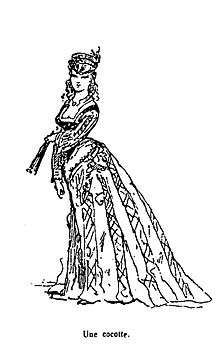Cocotte (prostitute)
Cocottes (or coquettes) were high class prostitutes (courtesans) in France during the Second Empire and the Belle Époque.[1] They were also known as demi-mondes and grandes horizontales.[2] Cocotte was originally a term of endearment for small children, but was used as a term for elegant prostitutes from the 1860s.[3] The term was also used in Wilhelmine and Weimar Germany from the turn of the 20th century (Kokotte).[4]

Overview
For some women, becoming a cocotte was also a way to achieve financial comfort before settling down in marriage. Some have managed their fortune, others have died in misery, others finally, like Sarah Bernhardt, who in the beginning was a cocotte, have become adulated actresses.[5]
For a rich man of the period, keeping a cocotte was seen as a symbol of his status and virility. Cocottes were elegant, fashionable and extravagant, the papers reported on their clothing, parties and affairs.[6]
Several authors of the 19c wrote about cocottes,[7] for example Émile Zola with Nana. This novel describes the life and tragic fate a street-walker who rises to become a cocotte, and whose ways lead to ruin the powerful men she meets.[8]
Famous cocottes include Cora Pearl (1835-1886) (her patrons included Prince Napoleon and the Duke of Morny); Laure Hayman (1851-1932) (Paul Bourget, King of Greece, Prince Karageorgevich and Prince Karl of Fürstenberg).[9] Several mansions of Paris were built for "cocottes", such as that of la Païva on the Champs-Élysées.[10]
References
- Rudorff, Raymond. "Courtesans and Prostitutes". www.indiana.edu. Retrieved 16 February 2019.
- Rounding 2004, p. 352.
- Smith 2014, p. 11.
- Smith 2014, pp. 2, 13.
- Laing, Olivia (23 October 2010). "Sarah: The Life of Sarah Bernhardt by Robert Gottlieb | book review". The Observer. Retrieved 16 February 2019.
- "Prostitution in Paris (1850-1910) Prequel of the billet about Memoirs of a cocodette written by herself by Ernest Feydeau". Book Around The Corner. 17 January 2016. Retrieved 16 February 2019.
- Chu & Dixon 2008, p. 203.
- Willsher, Kim (19 September 2015). "Cocottes, courtesans and sex in the city: Paris celebrates art of the demi-monde". The Observer. Retrieved 16 February 2019.
- Rose 2016, p. 322.
- "Albert-Ernest Carrier-Belleuse Console for the Grand Salon in the Hôtel de Païva". www.musee-orsay.fr. Musée d'Orsay. Retrieved 16 February 2019.
Bibliography
- Balducci, Richard (1993). Les Princesses de Paris: L'âge d'or des cocottes (in French). Hors collection (réédition numérique FeniXX). ISBN 9782258127975.
- Chu, Petra ten-Doesschate; Dixon, Laurinda S. (2008). Twenty-first-century Perspectives on Nineteenth-century Art: Essays in Honor of Gabriel P. Weisberg. Associated University Presse. ISBN 9780874130119.CS1 maint: ref=harv (link)
- Feydeau, Ernest (2013). Souvenirs d'une cocodette (in French). Numeriklivres. ISBN 9782897173999.
- Guigon, Catherine (2016). Les cocottes : reines du Paris 1900 (in French). Parigramme. ISBN 9782840969983.
- Pratt, Theodore (1951). Cocotte. Fawcett Publications.
- Rose, David Charles (2016). Oscar Wilde's Elegant Republic: Transformation, Dislocation and Fantasy in fin-de-siècle Paris. Cambridge Scholars Publishing. ISBN 9781443887632.CS1 maint: ref=harv (link)
- Rounding, Virginia (2004). Grandes Horizontales: The Lives and Legends of Four Nineteenth-century Courtesans. Bloomsbury. ISBN 9780747568599.CS1 maint: ref=harv (link)
- Smith, Jill Suzanne (2014). Berlin Coquette: Prostitution and the New German Woman, 1890–1933. Cornell University Press. ISBN 9780801469701.CS1 maint: ref=harv (link)